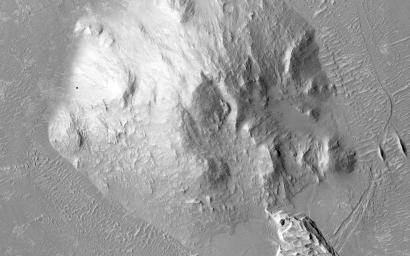
|
Differential Compaction around a Crater Peak
- Click the image above for a larger view
- Full-Res JPEG (2880 x 1800) (915.7 kB)
- Full-Res TIFF (2880 x 1800) (5.2 MB)
Caption:
This image shows a central peak that is surrounded by a ring-like graben feature and relatively flat terrain. Does the graben show evidence of what geologists call "differential compaction"?
Compaction refers to sediment that is originally porous and is covered up by other sediment (called "loading") that reduces that porousness. In other words, sand particles are pushed closer and closer together. Differential compaction is when there is variation in the thickness of a given area that creates uneven surface and has different degrees of porosity. The presence of the graben might be a clue to the formation of such unevenness.
Background Info:
HiRISE is one of six instruments on NASA's Mars Reconnaissance Orbiter. The University of Arizona, Tucson, operates the orbiter's HiRISE camera, which was built by Ball Aerospace & Technologies Corp., Boulder, Colo. NASA's Jet Propulsion Laboratory, a division of the California Institute of Technology in Pasadena, manages the Mars Reconnaissance Orbiter Project for the NASA Science Mission Directorate, Washington.
Cataloging Keywords:
| Name | Value | Additional Values |
|---|---|---|
| Target | Mars | |
| System | ||
| Target Type | Planet | |
| Mission | Mars Reconnaissance Orbiter (MRO) | |
| Instrument Host | Mars Reconnaissance Orbiter | |
| Host Type | Orbiter | |
| Instrument | High Resolution Imaging Science Experiment (HiRISE) | |
| Detector | ||
| Extra Keywords | Crater, Grayscale | |
| Acquisition Date | ||
| Release Date | 2013-10-02 | |
| Date in Caption | ||
| Image Credit | NASA/JPL-Caltech/Univ. of Arizona | |
| Source | photojournal.jpl.nasa.gov/catalog/PIA17575 | |
| Identifier | PIA17575 | |
